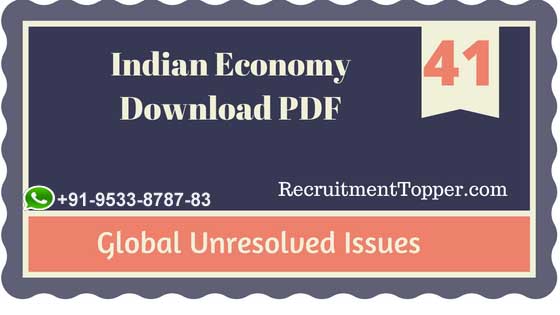Indian Economy | Global Unresolved Issues Download PDF
Contents
Unaddressed Issues
There are still a number of global unresolved issues, first being the absence of consensus at the WTO or in the inability to push through conclusion of the Doha round of negotiations which will be discussed in the next section. There are still other issues, potentially destabilizing in nature, which would need an early addressing and early resolutions such as:
(1) The issue of the continuation of ‘USD as an international reserve currency’. In the wake of crisis, many critics have favoured a neutral currency like the SDR as an international reserve currency.
If that happens, it may completely destabilize the US Economy and may lead to grave economic fall outs.
Any reserve currency will require it to be a currency in circulation for settling transactions, completely convertible, backed by a strong and large economy, globally acceptable and market-determined. All of which presently is satisfied only by the USD.
The issue of switching to some other currency should not arise as the problem is not with the currency but with US economy, as USD continues to be a strong currency and widely acceptable.
An unbiased collective view, putting to rest all speculations, would have to be taken in the ‘global’ interest for global stability.
(2) The future of Euro as a unified currency of the Euro zone has begun to show signs of cracking up especially with the recent crisis in Greece, Spain, Portugal, Ireland or the PIGS Economy which are not only destabilizing Euro zone but also smaller economies having the capabilities to destabilize the global economy.
The Euro has raised a number of fundamental questions of compatibility of smaller and larger economies, differential growth, differences in sectoral contribution of output, labour immobility, high levels of unsustainable deficits and different strategies for growth.
Whether Euro will survive or disintegrate is a big question mark? This will decide whether unified currency a good option or a limitation in the Euro zone.
(3) The ‘quantitative easing’ (QE) by the US of lowering reserves ratio to near zero first and then purchase of US securities from them market referred to as QEround2,is leading to surge
in inflows into emerging economies of the world, resulting in appreciating currencies, leading to ‘currency war’ situation with each economy trying to protect their respective currencies.
This would threaten the relevance of market-determined exchange rates.
This is also a dangerous proposition, as it fuels ‘carry trades’, which is money being utilized for earning higher returns in the emerging economies.
This could be destabilizing both for the US and emerging economies.
(4) With China becoming the second largest economy of the world and increased contribution to world trade, their reluctance to discontinue with their ‘pegged exchange rates’, would only distort world trade in future.
(5) There is a larger crisis in the making again epicentred in the US, which is credit card or plastic money becoming the preferred mode of transactions. The credit card market in the US is many more USD trillions.
It leverages spending beyond one’s means and a default similar to the sub-prime borrowers, can again potentially paralyze the financial system.
If the sub-prime borrowers were a USD 1.3 trillion market the credit card is more than double the market of around USD 3 trillion.
Can one fathom the fall outs of defaults in credit cards?
(6) The ageing workforce in countries such as US, Europe, Japan and others have grave fiscal implications of increased social security pension liabilities, representing unfunded public liabilities, have seeds of fiscal crisis as that seen in Greece and Ireland.
(7) Already the debt level of the US is over 100 per cent of its GDP, similarly for UK and the other European economies. Can such high levels of debt be sustainable in the long run? Probably, the emerging economies including India are fortunate that their debt levels though high but have not reached the levels seen in the US and other economies.
Clearly as said earlier, the global economy today is at crossroads, uncertain, highly fluid, with lots of question marks.
However, two things can be said with certainty, one that the emerging economies would increasingly play a very important role in reshaping the global economy and two that in multilateral trading lies the future.
Yet a recent disturbing trend is signs of recovery in the US and Europe is adversely affecting emerging economies with India included. While QE in the US was largely responsible for currencies in these economies appreciating, the reverse is happening. Withdrawal of QE or abandoning loose monetary stance has contributed to reversal of inflows in emerging economies resulting in their currency depreciating.
First the worry was global recovery and now the fall out of recovery in bigger economies has become a cause of concern. The concerns of economies like India are genuine and thus withdrawal of QE has to be gradual, not coming in the way of recovery and also not destabilizing emerging economies like India.

Leave a Reply